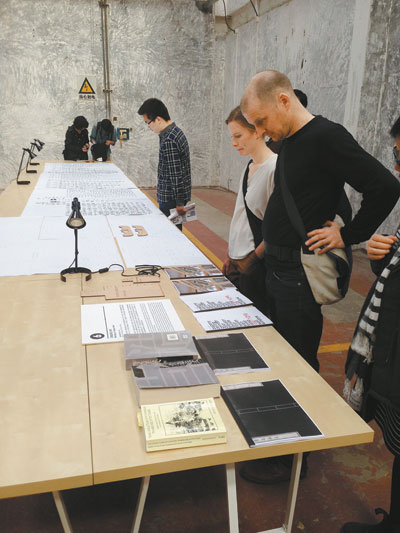
Anna Zhao
anna.whizh@yahoo.com
THE fifth Shenzhen-Hong Kong Bi-city Biennale Urbanism/Architecture in Shekou, Nanshan District, is an exploration of the urban border from two perspectives: the development of architectural design and the relationship between architecture and human life.
The exhibition includes two venues: a derelict glass factory building which was refurbished as the Value Factory that houses creative designs, and an old warehouse that was transformed into the Border Warehouse where the urban border is interpreted in myriad ways.
It is different from most in that other exhibition venues usually have locations to house their exhibits, but the Value Factory itself is the biggest exhibit that showcases architecture’s vitality under human design — the scrapped glass factory’s machine hall, silo, warehouse and outdoor spaces were reclaimed to provide fresh architectural experiences while its original identity was reserved.
A special material zone in the Value Factory illustrates that designers do more than just build with materials. Thirty-eight companies in the zone demonstrate how creative design helps people create even when materials become scarce or extremely expensive, and also how scarcity of materials can drive innovation.
A briefcase made from a package box, jewelry from old phone parts, a coffin adapted from couches, edible packages, leather shoes made from palm and more — designers prove that items can be recreated on original materials by changing their design.
Designers also have fresh ideas about how materials could be used in a world with extreme scarcity. In an imaginary virtual setting, a material called “polyblock” can be used repeatedly in printing, fashion is made of fabrics that people can grow, and crows are trained to pick up scrapped metals and other products.
By playing a shopping game, people who are addicted to shopping don’t have to actually shop to let their psychological addiction be satisfied. The “Marry Me” contract requires the owner of products to make a lifelong commitment with the products they own.
The Victoria and Albert Museum from London strikes a chord with visitors who don’t come from a design background. The collections in the museum offer penetrating insights into life in Shenzhen.
Rather than precious stones or valuables, the museum collects items in daily life that are not apparently appealing to artistic eyes, such as plastic basins, newspapers, penalty tickets, knockoff products, and even wire-free bras.
According to the curator, all the articles are suggested because they “tell stories about Shenzhen and life in Shenzhen today” by people who live and work in the city.
Knockoffs, or shanzhai products, offer a glimpse into low-cost manufacturing in Shenzhen. Though the products are counterfeit, they are not completely without ingenuity. For example, shanzhai iPhones have been labeled by its producer as an improved version of authentic ones.
“We first collect the stories via popular online platforms such as Weibo and Douban, then invite people to suggest the list and work with them to create this exhibition,” said Corinna Gardner, curator of contemporary product design of the museum.
The objects are all designed items with physical attributes about the city or its close relationship with Hong Kong. “We are showing the expertise of those who know the city best. We feel amazed to learn so much in the process. For example, the book about nature in the city, ‘The Notes of Landscape in Shenzhen,’ has taught us Shenzhen is a beautiful city with rich bio-diversity, in contrast to how most only think about the city’s factories,” said Corinna.
She said curating also means taking a risk. “We need to be very sensitive about the city, or otherwise, it could be just a Westerner’s look at the city, which is not we want to do at all. We want it to be absolute about being here, learning from people who know, rather than what we think it should be,” she said.
At the workshop of OMA, curator Cedric Van Parys worked with designers and Chinese students to translate China’s first complete theories on architecture design, “Yingzao Fashi” (“Treatise on Architectural Methods”) and reproduce the roof structure specified in it. Van Parys said the research is also a project for the Venice Biennale in 2014.
He said the research is very meaningful because Chinese people used the same structures ever since the Song Dynasty (960-1279) until very recently when steel replaced it. “Nowhere else in the world used this type of roof structure. I think it is really good to show the book to people and bring it to the public by translating and showing how valuable it is,” he said.
The Border Warehouse houses a wide variety of topics with its prime focuses on academic research on architecture and urban cities.
In addition to discussions of urban borders in Shenzhen and other places in the Pearl River Delta region, scholars have explored different borders or boundaries through multiple historical readings of cities. For instance, invisible boundaries exist between people who live and work inside and outside the checkpoint that used to mark the Shenzhen Special Economic Zone, and are reflected in almost every aspect of people’s lives, ranging from traffic, to security, education, healthcare and housing.
In addition to a regional hall by Macao, eight countries have set up country halls, including the United States, Britain, Italy, Spain, Mexico, Sweden, Canada and Belgium.
Venue A: Value Factory (Former Guangdong Float Glass Factory)
Add: 8 Haiwan Road, Nanshan District (南山区蛇口海湾路8号)
Bus: 226 (Bolichang Stop 玻璃厂站)
Venue B: Border House (Old Warehouse at Shekou Ferry Terminal)
Add: Gangwan Boulevard, Nanshan District (南山区港湾大道)
Metro: Shekou Line, Shekou Port Station (蛇口港站), Exit C
Time: Until Feb. 28, 2014
|

